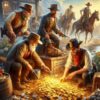Western Legends: Living the Life of a Cowboy
The image of the cowboy is deeply embedded in the American imagination, symbolizing adventure, independence, and rugged individualism. “Western Legends: Living the Life of a Cowboy” explores the realities behind the romanticized portrayal of cowboys in popular culture. This article delves into the daily lives, challenges, and enduring legacy of cowboys in the American West, providing a comprehensive look at their contributions to history and culture. By examining the true essence of cowboy life, we gain a clearer understanding of the legendary figures who shaped the frontier.

Part 1: The Cowboy’s World
The Historical Context
Cowboys emerged during the 19th century, a time of rapid expansion and settlement in the American West. The rise of cattle ranching, coupled with the need to drive large herds of cattle to railheads for transport, created the demand for skilled horsemen. This era was marked by significant economic and social changes, including the development of the cattle industry, the construction of railroads, and the establishment of new towns and settlements. Cowboys became essential figures in this transformative period, contributing to the expansion of the frontier and the growth of the American economy.
The Role of Cattle Ranching
Cattle ranching was the backbone of cowboy life. The vast open ranges of the West provided ideal conditions for raising cattle, and ranchers needed skilled cowboys to manage and move their herds. Cowboys were responsible for a range of tasks, including branding, roping, and herding cattle. The iconic cattle drives, which involved moving large herds from ranches to railheads, were central to the cowboy’s role and were crucial for the cattle industry’s success. These drives often covered hundreds of miles and required exceptional skill and endurance.
The Cowboy’s Equipment and Attire
Cowboys were known for their distinctive attire, which was both functional and symbolic. Key items included the wide-brimmed hat, which provided protection from the sun and rain; the bandana, used for various practical purposes; and the sturdy boots, essential for riding and working on the range. Their clothing was designed to withstand the harsh conditions of the frontier and to offer protection from the elements. Equipment such as the lasso, spurs, and firearms were also crucial tools for a cowboy, reflecting the practical demands of their daily work.
Part 2: The Daily Life of a Cowboy
Work and Responsibilities
A cowboy’s day was filled with hard work and varied tasks. Daily responsibilities included tending to cattle, repairing fences, and maintaining equipment. Cowboys often worked long hours in challenging conditions, from early morning until late at night. The work was physically demanding and required a high level of skill and endurance. Activities such as branding cattle, participating in roundups, and managing livestock were integral to their daily routines.
The Social Aspects of Cowboy Life
Despite the solitary nature of their work, cowboys formed tight-knit communities with fellow ranchers and cowhands. Social gatherings, such as barn dances, rodeos, and community events, provided opportunities for cowboys to interact and build relationships. These social aspects of cowboy life were important for maintaining morale and fostering a sense of camaraderie. The cowboy code, a set of unwritten rules emphasizing honor, integrity, and mutual respect, played a significant role in guiding behavior and interactions within these communities.
Challenges and Hardships
Life as a cowboy was fraught with challenges and hardships. Cowboys faced unpredictable weather, dangerous wildlife, and the physical demands of their work. Cattle drives, in particular, presented numerous risks, including potential conflicts with Native American tribes, encounters with outlaws, and the threat of disease affecting the cattle. The isolation of life on the range could also lead to feelings of loneliness and separation from family and friends. Despite these difficulties, cowboys demonstrated remarkable resilience and resourcefulness in navigating the demands of their lifestyle.
Part 3: The Legacy of the Cowboy
The Cowboy’s Impact on American Culture
The cowboy has become an enduring symbol of American culture, representing values such as independence, bravery, and rugged individualism. The imagery and myths surrounding cowboys have been popularized through literature, film, and television, contributing to a broader cultural narrative. Classic Western films and novels have portrayed cowboys as heroes and adventurers, shaping the public perception of the frontier and its iconic figures. The cowboy’s influence extends beyond entertainment, reflecting core American ideals and values.
The Evolution of the Cowboy Image
Over time, the image of the cowboy has evolved, incorporating both historical realities and romanticized portrayals. Early depictions often focused on the gritty and challenging aspects of cowboy life, while later representations emphasized a more idealized and heroic version. Modern portrayals continue to blend historical accuracy with creative interpretations, contributing to the ongoing fascination with cowboy culture. The evolution of the cowboy image reflects changing societal attitudes and cultural trends, highlighting the enduring appeal of this iconic figure.
Contemporary Cowboys and Ranching
While the traditional cowboy era has passed, contemporary cowboys and ranchers continue to uphold many of the values and practices associated with their predecessors. Modern ranching involves advanced techniques and technologies, but the core principles of hard work, dedication, and respect for the land remain central. Contemporary cowboys may work in various roles, including managing livestock, participating in rodeos, and preserving cowboy traditions. Their efforts contribute to maintaining the legacy of the cowboy while adapting to the demands of the 21st century.
Part 4: Lessons from the Cowboy Life
The Values of the Cowboy Code
The cowboy code, emphasizing honor, integrity, and mutual respect, offers valuable lessons for contemporary life. This code reflects the principles that guided cowboys in their interactions with others and in their approach to work and challenges. Embracing these values can provide insights into fostering strong relationships, maintaining personal integrity, and navigating complex situations with resilience and respect.
The Importance of Hard Work and Perseverance
The demanding nature of cowboy life highlights the importance of hard work and perseverance. Cowboys faced numerous obstacles and challenges, yet their determination and dedication enabled them to succeed. This emphasis on perseverance and a strong work ethic serves as a reminder of the value of commitment and effort in achieving personal and professional goals.
The Role of Community and Camaraderie
The sense of community and camaraderie among cowboys underscores the importance of support and connection in overcoming adversity. Despite the often solitary nature of their work, cowboys valued their relationships with fellow ranchers and cowhands. This aspect of cowboy life highlights the significance of building supportive networks and maintaining strong relationships in facing life’s challenges.
The Enduring Appeal of the Cowboy Spirit
The cowboy spirit, characterized by bravery, independence, and resilience, continues to captivate the imagination and inspire people today. The legendary figures of the Wild West embody qualities that resonate across time, reflecting universal themes of courage, adventure, and the pursuit of personal freedom. The enduring appeal of the cowboy spirit serves as a testament to the lasting impact of this iconic figure on American culture and beyond.
Conclusion
“Western Legends: Living the Life of a Cowboy” offers a comprehensive exploration of the true essence of cowboy life. From the historical context and daily responsibilities to the legacy and values associated with cowboys, this article provides a nuanced understanding of these iconic figures. The cowboy’s impact on American culture and the enduring appeal of the cowboy spirit reflect a rich and complex legacy that continues to inspire and captivate.
By examining the realities of cowboy life and the values they embodied, we gain a deeper appreciation for the contributions of these legendary figures to American history and culture. The lessons from their lives, including the importance of hard work, perseverance, and community, offer valuable insights for navigating contemporary challenges and fostering personal growth. As we reflect on the legacy of the cowboy, we honor the spirit of adventure, independence, and resilience that defines this enduring symbol of the American West.


